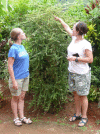Ethnomedicine and ethnobotany of fright, a Caribbean culture-bound psychiatric syndrome
- PMID: 20163730
- PMCID: PMC3583188
- DOI: 10.1186/1746-4269-6-9
Ethnomedicine and ethnobotany of fright, a Caribbean culture-bound psychiatric syndrome
Abstract
Background: "Fright" is an English-speaking Caribbean idiom for an illness, or ethnomedical syndrome, of persistent distress. A parallel ethnopsychiatric idiom exists in the French Antilles as sésisma. Fright is distinct from susto among Hispanics, though both develop in the wake of traumatic events. West Indian ethnophysiology (ethnoanatomy) theorizes that an overload of stressful emotions (fear, panic, anguish or worry) causes a cold humoral state in which blood coagulates causing prolonged distress and increased risks of other humorally cold illnesses.
Methods: Qualitative data on local explanatory models and treatment of fright were collected using participant-observation, informal key informant interviews and a village health survey. Ethnobotanical and epidemiological data come from freelist (or "free-list") tasks, analyzed for salience, with nearly all adults (N = 112) of an eastern village in Dominica, and a village survey on medicinal plant recognition and use (N = 106).
Results: Along with prayer and exercise, three herbs are salient fright treatments: Gossypium barbadense L., Lippia micromera Schauer, and, Plectranthus [Coleus] amboinicus [Loureiro] Sprengel. The survey indicated that 27% of village adults had medicated themselves for fright. Logistic regression of fright suffering onto demographic variables of age, education, gender, parental status and wealth measured in consumer goods found age to be the only significant predictor of having had fright. The probability of having (and medicating for) fright thus increases with every year.
Conclusions: While sufferers are often uncomfortable recalling personal fright experiences, reporting use of medicinal plants is less problematic. Inquiry on fright medical ethnobotany (or phytotherapies) serves as a proxy measurement for fright occurrence. Cross-cultural and ethnopharmacology literature on the medicinal plants suggests probable efficacy in accord with Dominican ethnomedical notions of fright. Further, the cultural salience and beliefs about these medicines may give these medications extra psychoneuroimmune (i.e. mind-body) benefits, or placebo-like effects, for this stress-related folk illness.
Figures





Similar articles
-
Ethnomedicine of menstruation in rural Dominica, West Indies.J Ethnopharmacol. 2014 May 14;153(3):624-34. doi: 10.1016/j.jep.2014.03.015. Epub 2014 Mar 15. J Ethnopharmacol. 2014. PMID: 24637192
-
Medicines in the forest: Ethnobotany of wild medicinal plants in the pharmacopeia of the Wichí people of Salta province (Argentina).J Ethnopharmacol. 2019 Mar 1;231:525-544. doi: 10.1016/j.jep.2018.10.026. Epub 2018 Nov 7. J Ethnopharmacol. 2019. PMID: 30414441
-
Patterns in medicinal plant knowledge and use in a Maroon village in Suriname.J Ethnopharmacol. 2016 Aug 2;189:319-30. doi: 10.1016/j.jep.2016.05.048. Epub 2016 May 20. J Ethnopharmacol. 2016. PMID: 27215681
-
An overview on ethnobotanico-pharmacological studies carried out in Morocco, from 1991 to 2015: Systematic review (part 1).J Ethnopharmacol. 2021 Mar 1;267:113200. doi: 10.1016/j.jep.2020.113200. Epub 2020 Aug 1. J Ethnopharmacol. 2021. PMID: 32750461
-
Historical versus contemporary medicinal plant uses in the US Virgin Islands.J Ethnopharmacol. 2016 Nov 4;192:74-89. doi: 10.1016/j.jep.2016.07.005. Epub 2016 Jul 1. J Ethnopharmacol. 2016. PMID: 27377341 Review.
Cited by
-
Principle of Hot and Cold and Its Clinical Application in Latin American and Caribbean Medicines.Adv Exp Med Biol. 2021;1343:57-83. doi: 10.1007/978-3-030-80983-6_5. Adv Exp Med Biol. 2021. PMID: 35015277 Review.
-
Knowledge and valuation of Andean agroforestry species: the role of sex, age, and migration among members of a rural community in Bolivia.J Ethnobiol Ethnomed. 2013 Dec 20;9:83. doi: 10.1186/1746-4269-9-83. J Ethnobiol Ethnomed. 2013. PMID: 24359597 Free PMC article.
-
Traditional uses of medicinal plants used by Indigenous communities for veterinary practices at Bajaur Agency, Pakistan.J Ethnobiol Ethnomed. 2018 Jan 29;14(1):11. doi: 10.1186/s13002-018-0212-0. J Ethnobiol Ethnomed. 2018. PMID: 29378636 Free PMC article.
-
Traditional medicine and childcare in Western Africa: mothers' knowledge, folk illnesses, and patterns of healthcare-seeking behavior.PLoS One. 2014 Aug 22;9(8):e105972. doi: 10.1371/journal.pone.0105972. eCollection 2014. PLoS One. 2014. PMID: 25147924 Free PMC article.
-
Caribbean Women's Health and Transnational Ethnobotany.Econ Bot. 2022;76(2):205-226. doi: 10.1007/s12231-021-09526-3. Epub 2021 Sep 10. Econ Bot. 2022. PMID: 34522053 Free PMC article.
References
-
- Allsopp R, ed. Dictionary of Caribbean English Usage. Kingston: University of West Indies Press; 1996.
-
- Farmer P. Bad blood, spoiled milk: Bodily fluids as moral barometers in rural Haiti. American Ethnologist. 1988;6:62–83. doi: 10.1525/ae.1988.15.1.02a00050. - DOI
-
- Farmer P. Sending Sickness: Sorcery, Politics, and Changing Concepts of AIDS in Rural Haiti. Medical Anthropology Quarterly New Series. 1990;6:6–27. doi: 10.1525/maq.1990.4.1.02a00020. - DOI
-
- Laguerre MS. Afro-Caribbean Folk Medicine. South Hadley, MA: Bergen & Garvey Publishers; 1987.
-
- Payne-Jackson A, Alleyne MC. Jamaican Folk Medicine: A Source of Healing. Kingston: University of West Indies Press; 2004.
Publication types
MeSH terms
Substances
LinkOut - more resources
Full Text Sources
Medical

